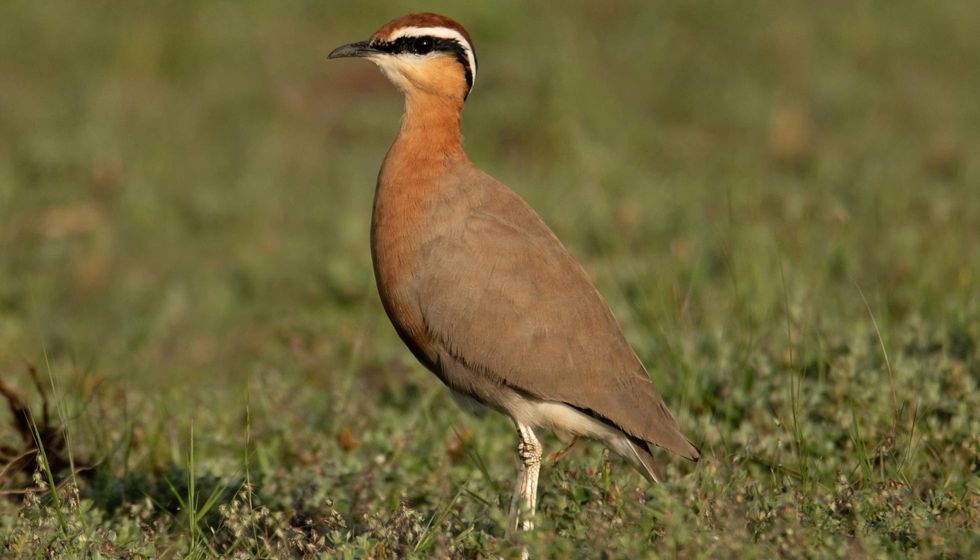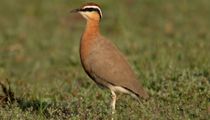The Jerdon's courser (Rhinoptilus bitorquatus) is also known as the double-banded courser. The courser species is closely related to the bronze-winged courser or violet-tipped courser (Rhinoptilus chalocopterus).
The Jerdon's courser is a Critically Endangered species as declared by the IUCN Red List of Threatened Species.
The bird species is one of the 50 rarest birds in the world, because of which very little information about the bird is available right now.
However, the researchers from the Bombay Natural History Society are constantly gathering more information on the species. According to P. Jeganathan, this bird is one of the rarest birds in the world, even rarer than tigers.
P. Jeganathan is a wildlife biologist working on gathering more information about the bird. According to him, since The bird is endemic to a certain part of India due to the degradation and shrinkage of its natural habitat of the scrub forest, the species is currently facing the threat of extinction.
According to wildlife biologist, P. Jeganathan, many places with habitats similar to the Jerdon's courser's habitat are yet to be surveyed to know if the bird population is present in these places as well.
For more relatable content, check out these red bird of paradise facts and common gallinule facts.
Jerdon's Courser Interesting Facts
What type of animal is a Jerdon's courser?
The Jerdon's courser, Rhinoptilus bitorquatus, is a very rare bird species found in a very small part of the world.
What class of animal does a Jerdon's courser belong to?
The Jerdon's courser, Rhinoptilus bitorquatus, belongs to the Aves class of the family Glareolidae.
How many Jerdon's coursers are there in the world?
The Jerdon's coursers are critically endangered species, so it is challenging to observe them. But with the help of high technology cameras established in the bird's wildlife sanctuary, it has been estimated that their population must range between 50-250.
Where does a Jerdon's courser live?
The Jerdon's courser, Rhinoptilus bitorquatus, lives in Sri Lankamaleshwara Wildlife Sanctuary in Andhra Pradesh, India. It is a residential species and is endemic to this part of the world only.
They can be found in the range of the Godavari river valley near Sironcha and Bhadrachalam; and the Cuddapah and Anantapur areas in the Pennar river valley in Andhra Pradesh.
What is a Jerdon's courser's habitat?
The Jerdon's courser prefers to live in a habitat with a thin strip of scrub forest between denser forest and grazed or cultivated areas. According to the sightings observed by the experts in Sri Lankamaleshawara Wildlife Sanctuary, the bird was found close to small water bodies in undulating grasslands with thin thorny scrub.
Who do Jerdon's coursers live with?
This species of courser bird is nocturnal probably likes to live alone.
How long does a Jerdon's courser live?
This courser species is known to live for seven years.
How do they reproduce?
The bird's breeding season is unknown since there is very little known about the Jerdon's courser. However, a male Jerdon's courser was found with developed glands in June; hence the experts suggest that this might indicate their breeding period.
Their typical clutch consists of one to two speckled and pale yellow eggs. After breeding, the juveniles might disperse and establish in new locations within their range. In the same range, they might make movements for feeding and breeding.
What is their conservation status?
The Jerdon's courser, Rhinoptilus bitorquatus, has been listed as Critically Endangered by the IUCN Red List of Threatened Species.
The courser has a declining population, mostly because the state of Andhra Pradesh relocated 57 villages in the area of Sri Lankamaleshwara to build the Somasilla dam.
The allocation of the human population to the courser's range affected their habitat since the humans became dependent on the forest for fodder and timber and started clearing the land for agricultural purposes.
In addition to this, excessive quarrying is also a threat to the species habitat, making them critically endangered.
Jerdon's Courser Fun Facts
What do Jerdon's coursers look like?

*We've been unable to source an image of a Jerdon's courser and have used an image of a Temminck's Courser instead. If you are able to provide us with a royalty-free image of a Jerdon's courser, we would be happy to credit you. Please contact us at hello@kidadl.com.
This small, Critically Endangered, and nocturnal bird has an overall sandy brown plumage. The bird's body is slim with an upright stance and long pale yellow legs.
Jerdon's courser's crown and neck are dark brown, while the crown also has a white stripe. The courser also has a broad brown supercilium. The species has two brown bands in their breast region with a chestnut throat patch and the tips of black primaries have a white patch.
They have white underparts, and their pale yellow eyes join in a V-shape. The tail of the Jerdon's courser is black in color, and their short bill is also black in color.
How cute are they?
This little courser species is fascinating and beautiful but equally rare to see because of being Critically Endangered.
How do they communicate?
The Jerdon's courser, Rhinoptilus bitorquatus, communicates through their call, which is a series of 'twick-too...twick-too' or 'yak-wak...yak-wak' sound. Their notes have been observed to be repeated at the rate of about one per second and uttered up to 16 times. It is also anticipated that the other birds in their area might join in their calling.
How big is a Jerdon's courser?
The Jerdon's courser is 10.6 in (27 cm) tall, almost the myna bird's height, a bird very commonly found in India.
How fast can a Jerdon's courser move?
Since very little information is known on this nocturnal and endangered species, how fast they move or fly is unknown.
How much does a Jerdon's courser weigh?
The Jerdon's courser (family Glareolidae) is so rare in population that a lot is still not known about the bird. Hence the weight of this bird species is also not known.
What are the male and female names of the species?
The Jerdon's courser male and female species do not have any separate names.
What would you call a baby Jerdon's courser?
A baby Jerdon's courser is called a nestling or a chick.
What do they eat?
Even though not a lot is known about this nocturnal bird, it is known that the Jerdon's courser is an insectivore and forages among bushes to eat slow-moving insects like termites and worms.
Are they dangerous?
No, they are not dangerous animals.
Would they make a good pet?
The Jerdon's courser should not be kept as a pet, because firstly, it is a Critically Endangered bird endemic to Andhra Pradesh. Secondly, the species is nocturnal in nature and does not publicize its presence.
Did you know...
The Jerdon's courser was first discovered by Thoma Jerdon, a British ornithologist and surgeon, in 1848.
He was posted as the Civil Surgeon of Nellore, where he became friendly with the people of Yanadi Tribes and got their help to get information on the local names of the birds found in that area.
The Jerdon's courser is called 'Kali Kalvi' in the Telugu language (the regional language of Andhra Pradesh, India) because the bush under which the birds are found is called 'Kalvi.'
But since Thomas Jerdon revealed the existence of this bird to the world, the bird was named as Jerdon's courser.
The Jerdon's courser's extinction and rediscovery
After the species was first discovered by Thomas Jerdon in 1848, it was again seen in the years 1871 and 1900.
After that, the species was not seen for about 80 years, and therefore the scientists thought that the bird has become extinct. But in 1986, Bharat Bhushan, a very enthusiastic ornithologist of Bombay Natural History Society, saw the bird in Sri Lamkamaleshawara(Andhra Pradesh, India), which was then declared as a sanctuary.
The last time the bird was seen was in 2009, only proving that if necessary actions for the conservation of their habitat aren't taken, the bird might go extinct for real this time.
What color eggs do Jerdon's coursers lay?
The Jerdon's courser lays speckled eggs that are pale yellow in color. The eggs are 0.78-1.18 in (2-3 cm) in length and very similar to the size of a small duck's eggs.
Here at Kidadl, we have carefully created lots of interesting family-friendly animal facts for everyone to discover! For more relatable content, check out these magpie facts and frigate bird facts for kids.
You can even occupy yourself at home by coloring in one of our free printable long-tailed mockingbird coloring pages.
Second image by Derek Keats.










